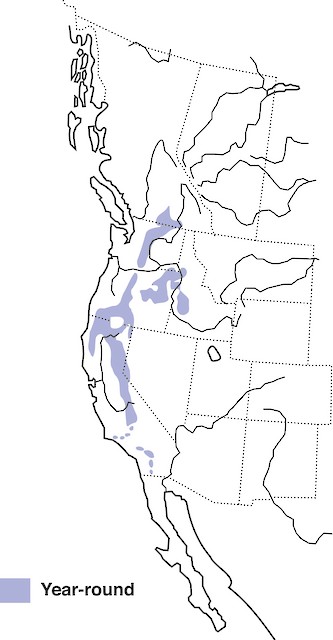In my mind's eye I am quite familiar with the Steller's jay. Particularly when we first moved to Southern California and drove into the mountains I recall seeing them on hikes and near campgrounds. However, when it comes to photos and identifications on iNaturalist, I've only seen three: one in 2000 somewhere in the San Bernardino Mountains (a horrible photo from far away); one in December 2024 near Oak Glen in the San Bernardino Mountains (a horrible blurry photo); and one in June 2025 near the Chilao Visitor Center in the San Gabriel Mountains (by far the best photos).
There are 16 to 17 subspecies which are separated into two groups: the northern group which has a long black crest and the southern group with a short blue crest. From there, the subspecies vary by the extent of black on the head, the color and extent of streaks on the forehead, presence and extent or absence of pale markings around the eye, the color of the throat and so on. I am a little perplexed that the subspecies found in Southern California is not specifically identified in the sources I'm looking at. Birds of the World has a coastal grouping which consists of: (a) C. s. stelleri, which gets as far south as northwestern California; (b) C. s. carlottae, which is found in the Queen Charlotte Islands of British Columbia; (c) C. s. frontalis found from central Oregon through the mountains of eastern California and west-central Nevada; and (d) C. s. carbonacea found from coastal central California south to Monterey County. Nowhere is Southern California identified. Birds of the World also identifies a southwest interior grouping which includes C. s. macrolopha found in the southern Rocky Mountains from Nevada east to western South Dakota and south to northern Sonora and Chihauhua. I just don't see how Southern California fits into that grouping. All About Birds refers to a coastal version found along the Pacific Coast which has blue streaks on the front of the crest and an interior version found in western evergreen forests which has white streaks on the front of the crest. That is probably the most helpful piece of information for me as my photo of the Steller's jay in the San Gabriel Mountains has a blue streak on the front of the crest. So apparently I am seeing a coastal version.
This range map from Birds of the World clearly shows populations in the Southern California mountains away from the coast.
C. s. carbonacea appears to be the most likely subspecies in Southern California. It is similar to C. s. stelleri, but paler overall and forehead streaks more extensive. Stelleri is identified as dark blue-black head, black crest, small light blue streaks on the forehead, lacking white eyearcs, pale throat streaked gray, neck and mantel dark blue-black, wing coverts blue with faint darker barring. An illustration of C. s. stelleri from Birds of the World follows:
Following are my photos:
 |
| This and the next photo were taken near Oak Glen in the San Bernardino Mountains. |























































